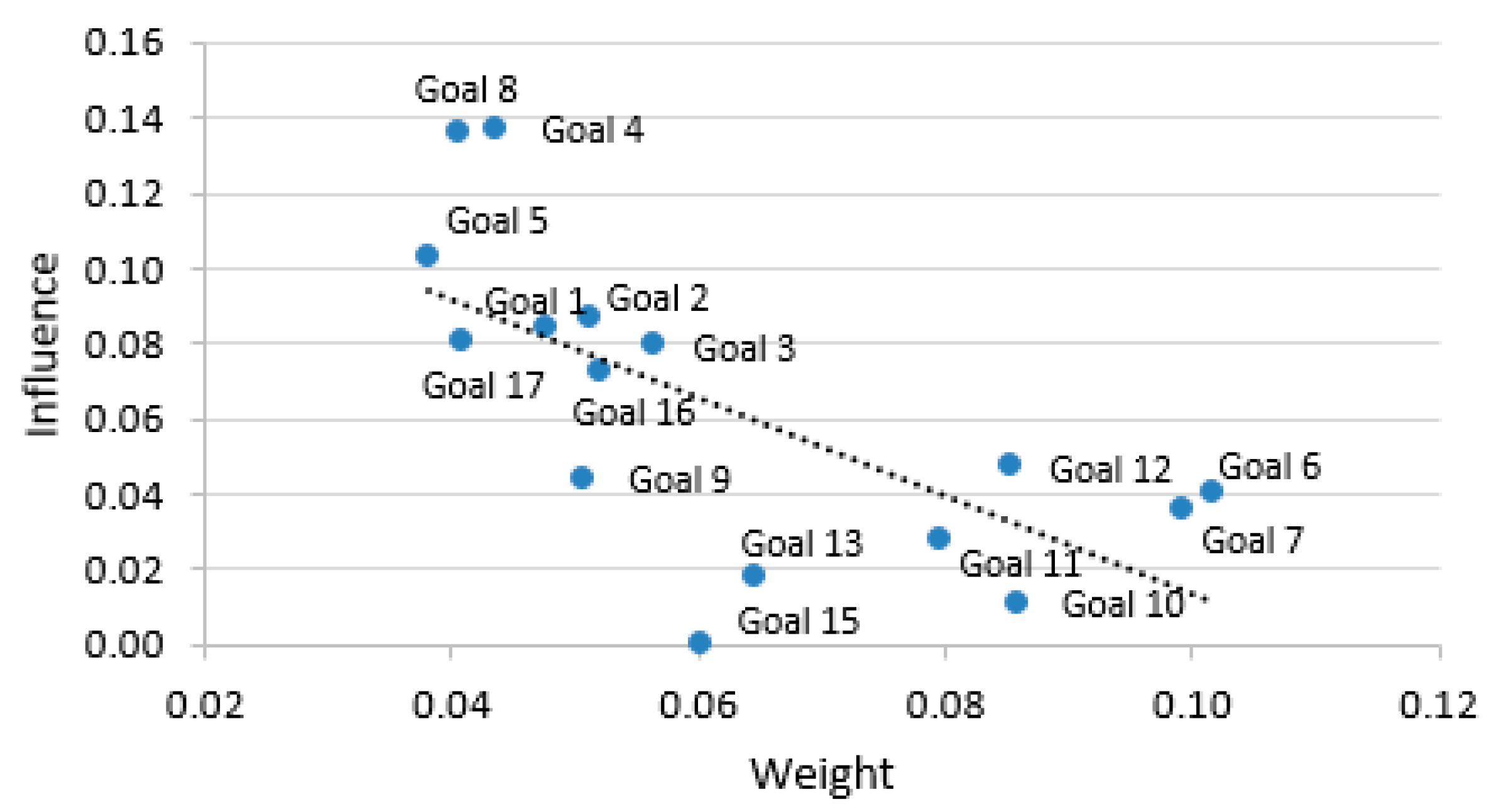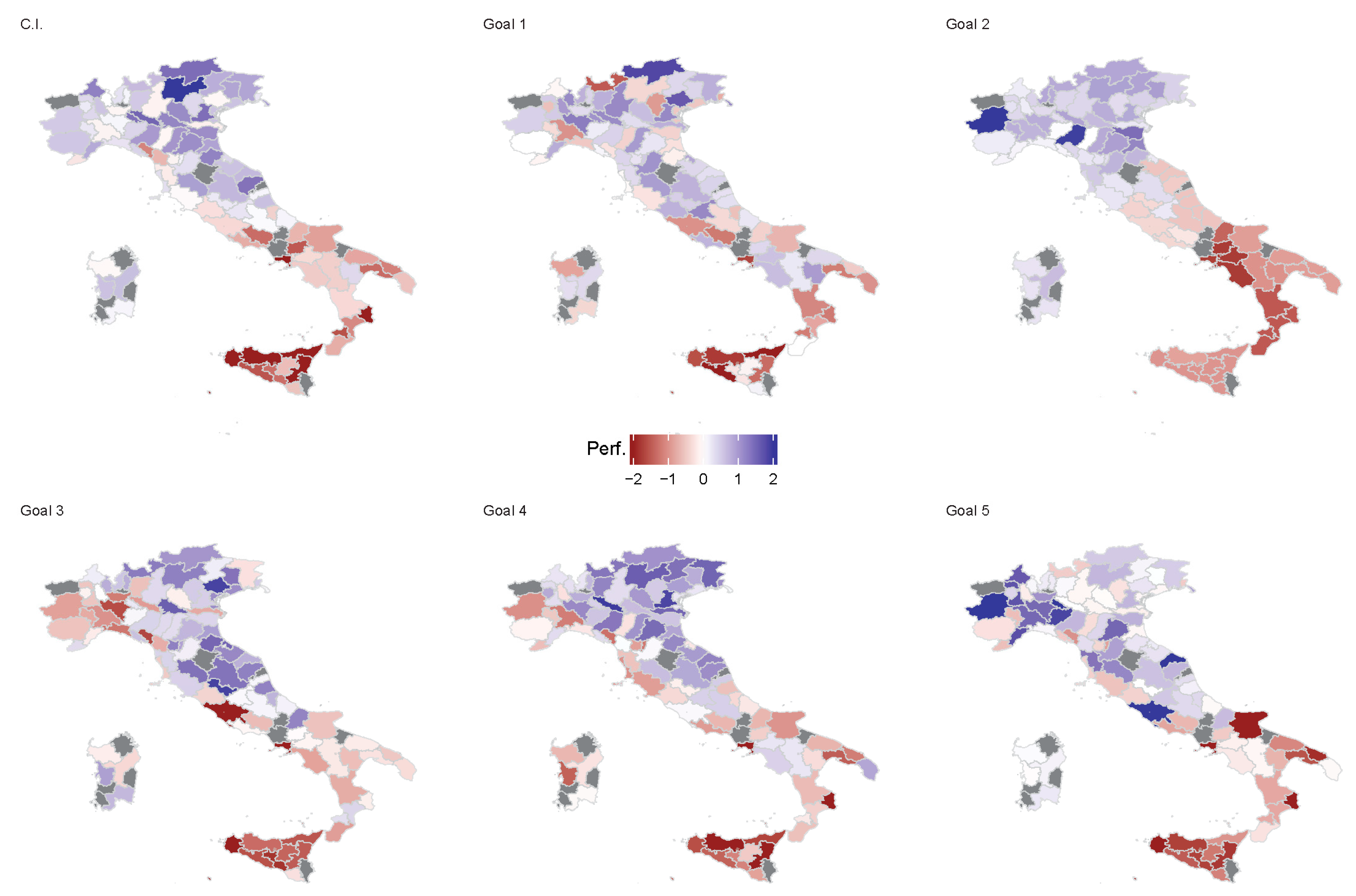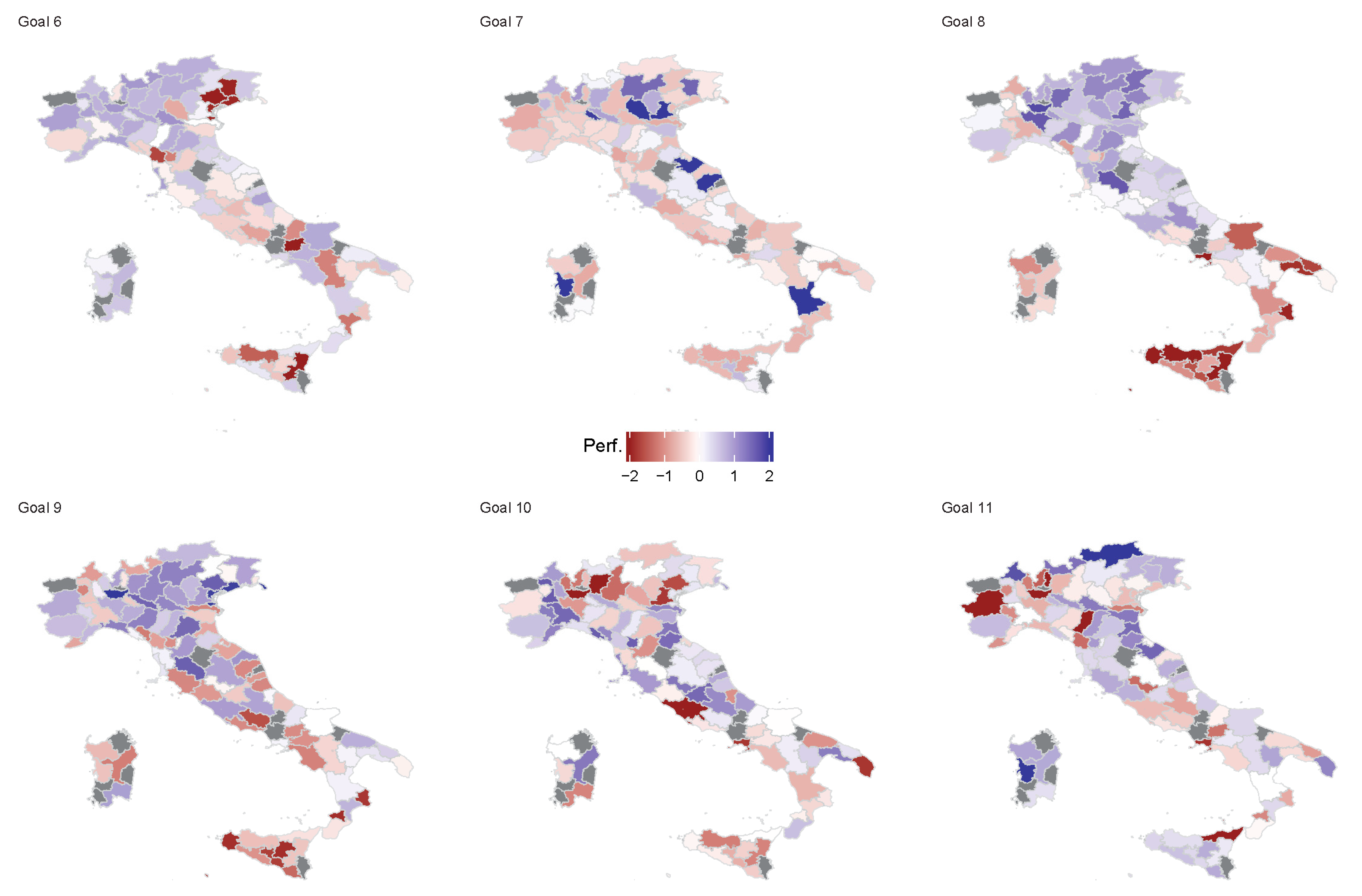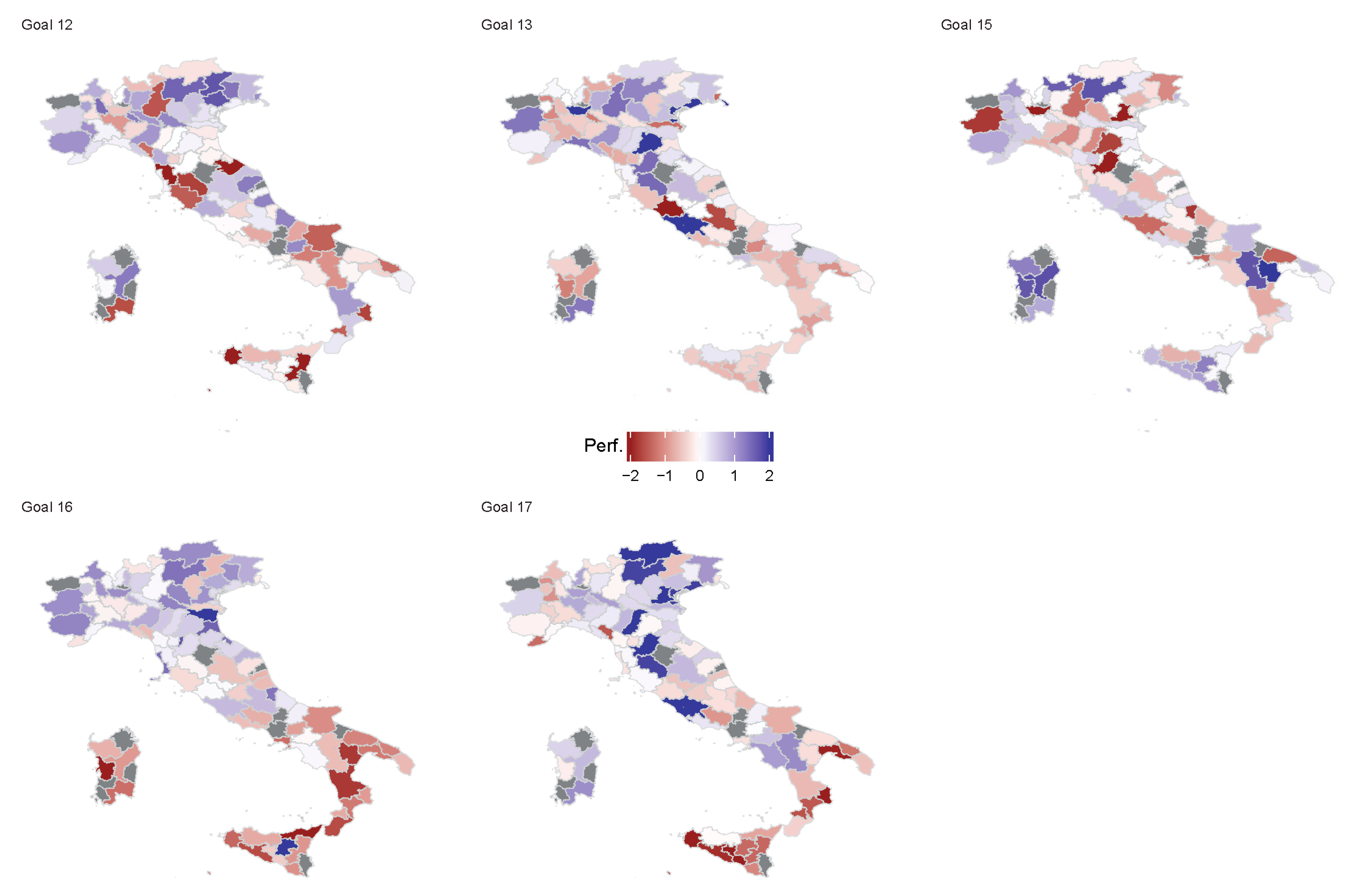Methodological Insights to Measure the Agenda 2030 at Urban Level in Italy
Abstract
:1. Introduction
2. Methodological Approach
2.1. Criteria Weighting
2.2. Final Goal’s Influence on the Composite Index
3. Results
4. Discussion and Conclusions
Author Contributions
Funding
Conflicts of Interest
Appendix A
| Indicator | Source | Year | SDGs | Polarity |
|---|---|---|---|---|
| Elderly people dependence index | ISTAT | 2017 | 1 | negative |
| Economic distress | MEF | 2013 | 1 | negative |
| Individuals in low-working intensity families | ISTAT | 2011 | 1 | negative |
| Urban bio gardens | URBES | 2013 | 2 | positive |
| Obesity rate | ISS | 2016 | 2 | negative |
| Healthy life expectancy at birth | ISTAT | 2016 | 3 | positive |
| Healthy life expectancy at 65 years | ISTAT | 2016 | 3 | positive |
| Deaths and injuries in road accidents | ISTAT | 2016 | 3 | negative |
| Support to elderly people | ISTAT | 2015 | 3 | positive |
| Suicide rate | URBES | 2011 | 3 | negative |
| Infant mortality rate | URBES | 2011 | 3 | negative |
| Nursery services for children aged 0–36 | ISTAT | 2013 | 4 | positive |
| Student literary competence | URBES | 2013/14 | 4 | positive |
| Student numerical competence | URBES | 2013/14 | 4 | positive |
| People with university degree | ISTAT | 2011 | 4 | positive |
| Population with low school license (isced 3) | ISTAT | 2011 | 4 | positive |
| Enrolled population at school aged 0–16 | ISTAT | 2011 | 4 | positive |
| Schools with ramps for people with disabilities | URBES | 2013 | 4 | positive |
| School with technologies | MIUR | 2015 | 4 | positive |
| Population with pre-university education | ISTAT | 2015 | 4 | positive |
| Employment gender balance | ISTAT | 2016 | 5 | positive |
| Woman mayor in the last 10 years | DATI.GOV.IT | 2016 | 5 | positive |
| Women educational level compared to men | URBES | 2011 | 5 | positive |
| Water losses | ISTAT | 2015 | 6 | negative |
| Population connected to urban wasted water treatment plants | ISTAT | 2015 | 6 | positive |
| Population served by sewerage | ISTAT | 2015 | 6 | positive |
| Solar PV installed | Legambiente | 2017 | 7 | positive |
| Average taxable income per capita | MEF | 2015 | 8 | positive |
| Neet (15–29) | URBES | 2011 | 8 | negative |
| Youngs aged 18–24 not enrolled in any educational course | URBES | 2011 | 8 | negative |
| Public transportation availability | Legambiente | 2017 | 9 | positive |
| Green firms | UNIONCAMERE | 2015 | 9 | positive |
| Connection infrastructure | Infratel | 2015 | 9 | positive |
| Gini index | MEF | 2014 | 10 | negative |
| Cycling road | Legambiente | 2017 | 11 | positive |
| People with no toilet | URBES | 2011 | 11 | negative |
| Pm 2.5 emission | ISPRA | 2017 | 11 | negative |
| Recycled waste | ISPRA | 2016 | 12 | positive |
| Urban waste | ISPRA | 2016 | 12 | negative |
| Incentive to recycling garden waste | ISPRA | 2016 | 12 | positive |
| Public transportation mobility | Legambiente | 2017 | 13 | positive |
| Bike sharing | ISTAT | 2015 | 13 | positive |
| Propensity to public transportation | ISTAT | 2015 | 13 | positive |
| CO2 emission | OECD | 2008 | 13 | negative |
| Share area utilization | SINAnet | 2016 | 15 | negative |
| Green urban areas per population | Legambiente | 2017 | 15 | positive |
| Ecolabel licenses | ISPRA | 2017 | 15 | positive |
| Political electoral participation | Min. dell’Interno | 2013 | 16 | positive |
| Tribunal efficiency | FPA | 2012 | 16 | negative |
| Firms rating | ISTAT | 2015 | 16 | positive |
| Broadband penetration rate | ISTAT | 2011 | 17 | positive |
| Propensity to association | ANCITEL | 2015 | 17 | positive |
| Social cooperatives | ISPRA | 2015 | 17 | positive |

| Municipality | S.I. | Municipality | Goal_1 | Municipality | Goal_2 | Municipality | Goal_3 | Municipality | Goal_4 | Municipality | Goal_5 |
|---|---|---|---|---|---|---|---|---|---|---|---|
| Trento | 2.30 | Bolzano | 1.83 | Torino | 5.61 | Terni | 1.91 | Cremona | 1.96 | Roma | 2.46 |
| Cremona | 1.51 | Treviso | 1.64 | Parma | 1.93 | Treviso | 1.89 | Padova | 1.85 | Lodi | 2.16 |
| Bolzano | 1.43 | Pavia | 1.27 | Ferrara | 1.43 | Mantova | 1.57 | Trento | 1.59 | Torino | 2.12 |
| Padova | 1.42 | Rieti | 1.16 | Ravenna | 1.18 | Rimini | 1.51 | Udine | 1.53 | Ancona | 2.06 |
| Lodi | 1.39 | Padova | 1.15 | Pordenone | 0.95 | Forli’ | 1.49 | Rovigo | 1.51 | Piacenza | 1.87 |
| Macerata | 1.37 | Brescia | 1.15 | Bologna | 0.94 | Siena | 1.38 | Bologna | 1.44 | Savona | 1.76 |
| Verbania | 1.23 | Trieste | 1.14 | Trento | 0.91 | Pordenone | 1.38 | Belluno | 1.39 | Vercelli | 1.70 |
| Forli’ | 1.21 | Varese | 1.13 | Cremona | 0.90 | Perugia | 1.37 | Sondrio | 1.35 | Verbania | 1.64 |
| Mantova | 1.18 | Cremona | 1.13 | Belluno | 0.90 | Sondrio | 1.29 | Parma | 1.33 | Bologna | 1.50 |
| Verona | 1.12 | Lodi | 1.05 | Bolzano | 0.87 | Trento | 1.23 | Ancona | 1.21 | Alessandria | 1.48 |
| Ferrara | 1.11 | Firenze | 1.05 | Como | 0.86 | Macerata | 1.23 | Bergamo | 1.20 | Pavia | 1.47 |
| Bologna | 1.10 | Novara | 0.99 | Padova | 0.85 | Pistoia | 1.23 | Forli’ | 1.16 | Pisa | 1.35 |
| Modena | 1.02 | Modena | 0.98 | Modena | 0.83 | Teramo | 1.22 | Pavia | 1.15 | Siena | 1.17 |
| Parma | 0.99 | Matera | 0.96 | Sondrio | 0.82 | Campobasso | 1.20 | Gorizia | 1.11 | Milano | 1.06 |
| Siena | 0.93 | Siena | 0.95 | Lecco | 0.81 | Pesaro | 1.16 | Macerata | 1.11 | Firenze | 0.92 |
| Catanzaro | −0.87 | Alessandria | −0.99 | Trapani | −0.97 | Cremona | −0.91 | Torino | −1.01 | Messina | −0.97 |
| Massa | −1.08 | Lecce | −0.99 | Agrigento | −0.97 | Alessandria | −0.99 | Caltanissetta | −1.13 | Massa | −1.00 |
| Brindisi | −1.12 | Roma | −0.99 | Messina | −0.97 | Milano | −1.20 | Brindisi | −1.18 | Bari | −1.09 |
| Caltanissetta | −1.15 | Cosenza | −1.08 | Matera | −0.98 | Genova | −1.25 | Alessandria | −1.18 | Ragusa | −1.15 |
| Frosinone | −1.32 | Taranto | −1.19 | Potenza | −0.98 | Palermo | −1.35 | Prato | −1.21 | Enna | −1.23 |
| Taranto | −1.33 | Vibo valentia | −1.19 | Campobasso | −1.41 | Enna | −1.41 | Massa | −1.30 | Agrigento | −1.49 |
| Benevento | −1.34 | Crotone | −1.20 | Reggio di Calabria | −1.52 | Catania | −1.49 | Agrigento | −1.44 | Taranto | −1.56 |
| Agrigento | −1.51 | Frosinone | −1.21 | Catanzaro | −1.52 | Messina | −1.55 | Oristano | −1.44 | Caltanissetta | −1.72 |
| Vibo valentia | −1.56 | Catania | −1.34 | Cosenza | −1.52 | Agrigento | −1.59 | Taranto | −1.47 | Palermo | −1.73 |
| Palermo | −1.57 | Sondrio | −1.51 | Vibo valentia | −1.52 | Pavia | −1.63 | Trapani | −1.61 | Catania | −1.80 |
| Crotone | −2.14 | Trapani | −1.60 | Crotone | −1.52 | Massa | −1.68 | Messina | −1.70 | Brindisi | −1.88 |
| Messina | −2.19 | Napoli | −1.69 | Napoli | −1.75 | Caltanissetta | −1.84 | Crotone | −2.05 | Foggia | −2.01 |
| Trapani | −2.38 | Palermo | −1.77 | Salerno | −1.77 | Roma | −2.20 | Catania | −2.09 | Napoli | −2.05 |
| Napoli | −2.44 | Agrigento | −4.01 | Avellino | −1.77 | Napoli | −2.87 | Palermo | −2.47 | Crotone | −2.06 |
| Catania | −2.54 | Messina | −4.55 | Benevento | −1.77 | Trapani | −3.12 | Napoli | −2.91 | Trapani | −2.10 |
| Municipality | Goal_6 | Municipality | Goal_7 | Municipality | Goal_8 | Municipality | Goal_9 | Municipality | Goal_10 | Municipality | Goal_11 |
|---|---|---|---|---|---|---|---|---|---|---|---|
| Mantova | 1.07 | Padova | 3.96 | Milano | 1.80 | Milano | 2.78 | Vercelli | 1.63 | Bolzano | 2.07 |
| Milano | 1.02 | Macerata | 3.66 | Pavia | 1.65 | Trieste | 2.19 | La Spezia | 1.60 | Oristano | 2.03 |
| Sondrio | 1.01 | Pesaro | 3.56 | Siena | 1.64 | Venezia | 1.94 | Pistoia | 1.59 | Verbania | 1.73 |
| Livorno | 0.93 | Verona | 3.32 | Padova | 1.52 | Treviso | 1.58 | Rieti | 1.48 | Pesaro | 1.51 |
| Torino | 0.92 | Oristano | 2.27 | Bergamo | 1.47 | Siena | 1.57 | Alessandria | 1.48 | Ravenna | 1.44 |
| Vercelli | 0.92 | Cosenza | 2.16 | Belluno | 1.44 | Cremona | 1.52 | Forli’ | 1.46 | Sondrio | 1.41 |
| Teramo | 0.91 | Lodi | 1.95 | Treviso | 1.20 | Bologna | 1.47 | Terni | 1.35 | Ferrara | 1.31 |
| Genova | 0.91 | Pordenone | 1.52 | Trento | 1.18 | Genova | 1.24 | Ravenna | 1.34 | Mantova | 1.30 |
| Lecco | 0.89 | Trento | 1.47 | Parma | 1.11 | Trento | 1.23 | Nuoro | 1.33 | Lecce | 1.19 |
| Cremona | 0.86 | Como | 1.02 | Bologna | 1.09 | Parma | 1.23 | Asti | 1.28 | Forli’ | 1.17 |
| Foggia | 0.85 | Cremona | 0.92 | L’Aquila | 1.07 | Brescia | 1.19 | Taranto | 1.28 | Cremona | 1.02 |
| Varese | 0.84 | Bergamo | 0.84 | Varese | 1.03 | Mantova | 1.19 | Savona | 1.22 | Modena | 1.00 |
| Piacenza | 0.82 | Vicenza | 0.82 | Bolzano | 1.02 | Bergamo | 1.06 | Rovigo | 1.21 | Pistoia | 0.99 |
| Trento | 0.81 | Verbania | 0.79 | Lodi | 0.98 | Ancona | 1.05 | Livorno | 1.20 | Matera | 0.89 |
| Modena | 0.81 | Biella | 0.73 | Lecco | 0.90 | Firenze | 1.00 | Massa | 1.18 | Sassari | 0.87 |
| Taranto | −0.57 | Vibo valentia | −0.70 | Ragusa | −0.96 | Macerata | −1.08 | Firenze | −1.00 | Asti | −1.06 |
| Rieti | −0.62 | Reggio di Calabria | −0.72 | Cosenza | −0.99 | Teramo | −1.08 | Pescara | −1.01 | Biella | −1.07 |
| Verona | −0.79 | Campobasso | −0.72 | Bari | −0.99 | Grosseto | −1.08 | Cagliari | −1.12 | Vibo valentia | −1.09 |
| Frosinone | −0.86 | Napoli | −0.75 | Agrigento | −1.02 | Rovigo | −1.10 | Catania | −1.13 | Rovigo | −1.19 |
| Campobasso | −1.06 | Trieste | −0.75 | Sassari | −1.04 | Biella | −1.13 | Palermo | −1.17 | Varese | −1.19 |
| Potenza | −1.15 | Rovigo | −0.76 | Foggia | −1.47 | Salerno | −1.14 | Como | −1.24 | Benevento | −1.28 |
| Pistoia | −1.17 | Torino | −0.77 | Caltanissetta | −1.59 | Nuoro | −1.17 | Varese | −1.27 | Lucca | −1.33 |
| Catanzaro | −1.26 | Nuoro | −0.77 | Brindisi | −1.70 | Massa | −1.20 | Brescia | −1.34 | Terni | −1.35 |
| Palermo | −1.47 | Viterbo | −0.78 | Messina | −1.80 | Ragusa | −1.38 | Treviso | −1.62 | Como | −1.46 |
| Lucca | −1.68 | Varese | −0.78 | Taranto | −1.86 | Frosinone | −1.60 | Padova | −1.79 | Napoli | −1.85 |
| Venezia | −1.93 | Latina | −0.79 | Crotone | −1.95 | Caltanissetta | −1.74 | Lecce | −1.82 | Milano | −2.05 |
| Pordenone | −1.95 | Palermo | −0.80 | Trapani | −2.41 | Crotone | −1.81 | Napoli | −1.82 | Lecco | −2.44 |
| Benevento | −3.02 | Lucca | −0.81 | Palermo | −2.52 | Trapani | −1.87 | Roma | −2.15 | Torino | −2.64 |
| Treviso | −4.20 | Enna | −0.83 | Napoli | −2.87 | Enna | −1.87 | Bergamo | −2.49 | Reggio nell’Emilia | −2.66 |
| Catania | −4.85 | Taranto | −0.83 | Catania | −3.15 | Vibo valentia | −1.89 | Milano | −3.93 | Messina | −3.07 |
| Municipality | Goal_12 | Municipality | Goal_13 | Municipality | Goal_15 | Municipality | Goal_16 | Municipality | Goal_17 |
|---|---|---|---|---|---|---|---|---|---|
| Belluno | 1.68 | Venezia | 4.33 | Matera | 5.04 | Enna | 3.05 | Roma | 2.67 |
| Treviso | 1.68 | Milano | 3.75 | Nuoro | 1.76 | Ferrara | 2.45 | Firenze | 2.35 |
| Trento | 1.53 | Roma | 2.17 | Trento | 1.70 | Prato | 1.70 | Padova | 2.26 |
| Novara | 1.42 | Bologna | 2.00 | Potenza | 1.68 | Ravenna | 1.54 | Modena | 2.10 |
| Pordenone | 1.35 | Trieste | 2.00 | Oristano | 1.66 | Livorno | 1.42 | Bolzano | 2.02 |
| Nuoro | 1.31 | Siena | 1.48 | Sondrio | 1.60 | Trento | 1.38 | Venezia | 1.94 |
| Macerata | 1.28 | Firenze | 1.45 | Enna | 1.24 | Rimini | 1.37 | Trento | 1.89 |
| Lodi | 1.26 | Brescia | 1.42 | Sassari | 1.24 | Pescara | 1.36 | Siena | 1.89 |
| Teramo | 1.22 | Genova | 1.39 | Ragusa | 1.08 | Mantova | 1.21 | Potenza | 1.12 |
| Chieti | 1.21 | Torino | 1.35 | Verbania | 1.02 | Cuneo | 1.20 | Cagliari | 1.10 |
| Mantova | 1.18 | Cagliari | 1.34 | Caltanissetta | 0.94 | Verona | 1.17 | Udine | 1.03 |
| Benevento | 1.15 | Trento | 1.21 | Cuneo | 0.86 | Verbania | 1.13 | Salerno | 0.96 |
| Gorizia | 1.09 | Parma | 1.06 | Cagliari | 0.85 | Bolzano | 1.13 | Cremona | 0.94 |
| Asti | 1.07 | Rimini | 0.90 | Agrigento | 0.80 | Milano | 1.11 | Milano | 0.93 |
| Cuneo | 1.07 | Verona | 0.89 | Gorizia | 0.74 | Torino | 1.10 | Como | 0.88 |
| Potenza | −0.99 | Sondrio | −0.76 | Cosenza | −0.79 | Ragusa | −1.01 | Frosinone | −0.96 |
| Avellino | −1.17 | Lucca | −0.76 | Verona | −0.81 | Foggia | −1.03 | Vercelli | −0.99 |
| Brindisi | −1.32 | Massa | −0.80 | Parma | −1.04 | Bari | −1.13 | Ragusa | −1.10 |
| Massa | −1.32 | Lecco | −0.82 | Modena | −1.06 | Brindisi | −1.13 | Brindisi | −1.24 |
| Foggia | −1.44 | Nuoro | −0.85 | Udine | −1.08 | Catanzaro | −1.21 | Imperia | −1.33 |
| Vibo valentia | −1.45 | Catanzaro | −0.89 | Brescia | −1.31 | Taranto | −1.22 | Enna | −1.37 |
| Grosseto | −1.48 | Taranto | −0.99 | Roma | −1.35 | Cagliari | −1.31 | Catania | −1.39 |
| Brescia | −1.54 | Vercelli | −1.07 | Napoli | −1.41 | Napoli | −1.32 | Catanzaro | −1.51 |
| Cagliari | −1.61 | Benevento | −1.08 | Bari | −1.43 | Trapani | −1.39 | Massa | −1.54 |
| Crotone | −1.70 | Oristano | −1.16 | Bologna | −1.71 | Agrigento | −1.62 | Vibo valentia | −1.58 |
| Siena | −1.73 | Lodi | −1.19 | Torino | −1.78 | Reggio di Calabria | −1.63 | Agrigento | −1.88 |
| Pisa | −2.03 | Rovigo | −1.31 | Pescara | −1.81 | Matera | −1.79 | Taranto | −1.97 |
| Trapani | −2.09 | Gorizia | −1.36 | Firenze | −2.03 | Cosenza | −1.79 | Crotone | −2.00 |
| Catania | −2.57 | L’Aquila | −1.64 | Milano | −2.38 | Oristano | −2.21 | Trapani | −2.34 |
| Pesaro | −4.18 | Viterbo | −2.35 | Padova | −2.39 | Messina | −2.92 | Caltanissetta | −2.62 |



References
- Prakash, M.; Teksoz, K.; Espey, J.; Sachs, J.; Shank, M.; Schmidt-Traub, G. Achieving a Sustanable Urban America; SDSN Report; Sustainable Development Solutions Network (SDSN): New York, NY, USA, 2017. [Google Scholar]
- Sachs, J.; Schmidt-Traub, G.; Kroll, C.; Lafortune, G.; Fuller, G. SDG Index and Dashboards Report 2018; Bertelsmann Stiftung and Sustainable Development Solutions Network (SDSN): New York, NY, USA, 2018. [Google Scholar]
- Cavalli, L. Da Agenda 2030 Globale ad Agenda 2030 Locale; FEEM Report; FEEM: Milano, Italy, 2018; Available online: https://www.feem.it/en/publications/reports/agenda-2030-da-globale-a-locale/ (accessed on 3 June 2019).
- OECD. Measuring Distance to the SDG Targets: An Assessment of Where OECD Countries Stand. 2017. Available online: http://www.oecd.org/std/OECD-Measuring-Distanceto-SDG- (accessed on 3 June 2019).
- EUROSTAT. Sustainable Development in the European Union; Overview Progress on the Goals in the EU Context; European Commission: Brussels, Belgium, 2017. [Google Scholar]
- AsviS. L’Italia e gli Obiettivi di Sviluppo Sostenibile; Report; Editron srl: Roma, Italy, 2017. [Google Scholar]
- Campagnolo, L.; Carraro, C.; Eboli, F.; Farnia, L.; Parrado, R.; Pierfederici, R. The Ex-Ante Evaluation of Achieving Sustainable Development Goals. Soc. Indic. Res. 2018, 136, 73–116. [Google Scholar] [CrossRef]
- Alberti, M. Measuring Urban Sustainability. Environ. Impact Assess. Rev. 1996, 16, 381–424. [Google Scholar] [CrossRef]
- Elmqvist, T.; Frantzeskaki, N.; Maddox, D.; Parnell, S.; Simon, D.; Bai, X.; Griffith, C.; McPhearson, T.; Romero-Lankao, P.; Watkins, M. The Urban Planet: Knowledge Towards Sustainable Cities; Cambridge University Press: Cambridge, UK, 2018. [Google Scholar]
- Wong, C. Quantitative Indicators for Urban and Regional Planning: The Interplay of Policy and Methods; Routledge: London, UK, 2006; Available online: www.un.org/sustainabledevelopment/development-agenda/ (accessed on 3 June 2019).
- Wong, C. A Framework for ‘City Prosperity Index’: Linking Indicators, Analysis and Policy. Habitat Int. 2014, 45, 3–9. [Google Scholar] [CrossRef]
- Herva, M.; Franco, A.; Carrasco, E.F.; Roca, E. Review of corporate environmental indicators. J. Clean. Prod. 2011, 19, 1687–1699. [Google Scholar] [CrossRef] [Green Version]
- Sirgy, M.J.; Lee, D.; Miller, C.; Littlefield, J.E. The Impact of Globalization on a Country’s Quality of Life: Toward an Integrated Model. Soc. Ind. Res. 2004, 68, 251–298. [Google Scholar] [CrossRef]
- Prescott-Allen, R. The Wellbeing of Nations: A Contry-by-Country Index of Quality of Life and the Environment; International Development Research Centre, Island Press/Ottawa: Washington, DC, USA, 2001. [Google Scholar]
- Sanchez Rodriguez, R.; Ürge-Vorsatz, D.; Salisu Barau, A. Sustainable Development Goals and climate change adaption in cities. Nat. Clim. Chang. 2018, 8, 181–183. [Google Scholar] [CrossRef]
- Li, X.; Woetzel, J.; Zhang, G.; Zhang, Y. The China Urban Sustainability Index 2013. In Urban China Initiative; Urban China Initiative: Beijing, China, 2014. [Google Scholar]
- Van Dijken, K.; Dorenbos, R.; Kamphof, R. The Reference Framework for Sustainable Cities (RFSC): Testing Results and Recommendations; Nicis Institute: Den Haag, The Netherlands, 2012. [Google Scholar]
- Watson, J. European Green City Index: Assessing the Environmental Impact of Europe’s Major Cities; Economist Intelligence Unit; Siemens: Munich, Germany, 2009. [Google Scholar]
- Mazziotta, M.; Pareto, A. On a Generalized Non-compensatory Composite Index for Measuring Socio-economic Phenomena. Soc. Indic. Res. 2016, 127, 983–1003. [Google Scholar] [CrossRef]
- Munda, G. Social multi-criteria evaluation for urban sustainability policies. Land Use Policy 2006, 23, 86–94. [Google Scholar] [CrossRef]
- Munda, G. Measuring sustainability: A multi-criterion framework. Environ. Dev. Sustain. 2005, 7, 117–134. [Google Scholar] [CrossRef]
- Farnia, L. On the Use of Spectral Value Decomposition for the Construction of Composite Indices; FEEM Working Paper; FEEM: Milano, Italy, 2019. [Google Scholar] [CrossRef]
- Wang, W.; Stanley, J. Differential weighting: A review of methods and empirical studies. Rev. Educ. Res. 1970, 40, 663–705. [Google Scholar] [CrossRef]
- Parulo, P.; Saisana, M.; Saltelli, A. Rating and Rankings: Vodoo or science? J. R. Statist. Soc. 2013, 176, 609–634. [Google Scholar] [CrossRef]
- OECD. Handbook on Constructing Composite Indicators: Methodology and UserGuide; OECD Publishing: Paris, France, 2005. [Google Scholar]
- Nicoletti, G.; Scarpetta, G.; Boylaud, O. Summary Indicators of Product Market Regulation with an Extension to Employment Protection Legislation. In OECD Economics Department Working Papers; OECD Publishing: Paris, France, 2000. [Google Scholar] [Green Version]


| Goal | Std. Infl. | Weight | Goal | Std. Infl. | Weight |
|---|---|---|---|---|---|
| Goal 4 | 0.137 | 0.044 | Goal 12 | 0.047 | 0.085 |
| Goal 8 | 0.136 | 0.041 | Goal 9 | 0.044 | 0.051 |
| Goal 5 | 0.103 | 0.038 | Goal 6 | 0.040 | 0.102 |
| Goal 2 | 0.087 | 0.051 | Goal 7 | 0.036 | 0.099 |
| Goal 1 | 0.084 | 0.048 | Goal 11 | 0.028 | 0.080 |
| Goal 17 | 0.081 | 0.041 | Goal 13 | 0.018 | 0.065 |
| Goal 3 | 0.079 | 0.057 | Goal 10 | 0.011 | 0.086 |
| Goal 16 | 0.072 | 0.052 | Goal 15 | 0.000 | 0.060 |
© 2019 by the authors. Licensee MDPI, Basel, Switzerland. This article is an open access article distributed under the terms and conditions of the Creative Commons Attribution (CC BY) license (http://creativecommons.org/licenses/by/4.0/).
Share and Cite
Farnia, L.; Cavalli, L.; Lizzi, G.; Vergalli, S. Methodological Insights to Measure the Agenda 2030 at Urban Level in Italy. Sustainability 2019, 11, 4598. https://doi.org/10.3390/su11174598
Farnia L, Cavalli L, Lizzi G, Vergalli S. Methodological Insights to Measure the Agenda 2030 at Urban Level in Italy. Sustainability. 2019; 11(17):4598. https://doi.org/10.3390/su11174598
Chicago/Turabian StyleFarnia, Luca, Laura Cavalli, Giula Lizzi, and Sergio Vergalli. 2019. "Methodological Insights to Measure the Agenda 2030 at Urban Level in Italy" Sustainability 11, no. 17: 4598. https://doi.org/10.3390/su11174598
APA StyleFarnia, L., Cavalli, L., Lizzi, G., & Vergalli, S. (2019). Methodological Insights to Measure the Agenda 2030 at Urban Level in Italy. Sustainability, 11(17), 4598. https://doi.org/10.3390/su11174598







